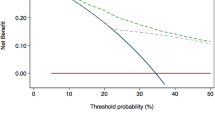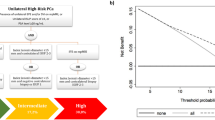Abstract
Purpose
Nomograms predicting side-specific extraprostatic extension (EPE) may be applied to reduce positive surgical margin (PSM) rates in patients planned for radical prostatectomy (RP). This study evaluates the impact of implementing an externally validated nomogram for side-specific EPE on PSM rate and degree of nerve-sparing.
Methods
In patients planned for RP, the side-specific nomogram predictions (based on MRI, ISUP grade group, and PSA density), with an advised threshold of 20% for safe nerve-sparing, were presented preoperatively to the urological surgeon. The surgeon completed a survey before RP about the planning with respect to side-specific nerve-sparing and change of management due to the result of the nomogram. PSM rates and degree of nerve-sparing were compared to a retrospective control group treated in the months prior to the introduction of the nomogram.
Results
A total of 100 patients were included, 50 patients in both groups representing 200 prostate lobes. Of the patients, 37% had histologically confirmed EPE, and 40% a PSM. In 12% of the 100 lobes planned after nomogram presentation, a change in management due to the nomogram was reported. A per-prostate lobe analysis of all the lobes showed comparable rates of full nerve-sparing (45% vs. 30%; p = 0.083) and lower rates of PSM on the lobes with histological EPE (45% vs. 85%; p < 0.05) in the intervention (nomogram) group versus the control group.
Conclusion
Implementing a predictive nomogram for side-specific EPE in the surgical planning for nerve-sparing leads to lower rates PSM on the side of the histological EPE without compromising nerve-sparing.
Similar content being viewed by others
References
Bill-Axelson A, Holmberg L, Garmo H et al (2018) Radical prostatectomy or watchful waiting in prostate cancer—29-year follow-up. N Engl J Med 379:2319–2329. https://doi.org/10.1056/NEJMoa1807801
Holze S, Bräunlich M, Mende M et al (2022) Age-stratified outcomes after radical prostatectomy in a randomized setting (LAP-01): do younger patients have more to lose? World J Urol. https://doi.org/10.1007/s00345-022-03945-0
Walsh PC (2007) The discovery of the cavernous nerves and development of nerve sparing radical retropubic prostatectomy. J Urol 177:1632–1635. https://doi.org/10.1016/j.juro.2007.01.012
Nguyen LN, Head L, Witiuk K et al (2017) The risks and benefits of cavernous neurovascular bundle sparing during radical prostatectomy: a systematic review and meta-analysis. J Urol 198:760–769. https://doi.org/10.1016/j.juro.2017.02.3344
Soeterik TFW, van Melick HHE, Dijksman LM et al (2020) Nerve sparing during robot-assisted radical prostatectomy increases the risk of ipsilateral positive surgical margins. J Urol 204:91–95. https://doi.org/10.1097/JU.0000000000000760
Morizane S, Yumioka T, Makishima K et al (2021) Impact of positive surgical margin status in predicting early biochemical recurrence after robot-assisted radical prostatectomy. Int J Clin Oncol 26:1961–1967. https://doi.org/10.1007/s10147-021-01977-x
Mottet N, van den Bergh RCN, Briers E et al (2021) EAU-EANM-ESTRO-ESUR-SIOG guidelines on prostate cancer-2020 update. part 1: screening, diagnosis, and local treatment with curative intent. Eur Urol 79:243–262. https://doi.org/10.1016/j.eururo.2020.09.042
Ohori M, Kattan MW, Koh H et al (2004) Predicting the presence and side of extracapsular extension: a nomogram for staging prostate cancer. J Urol 171:1844–1849. https://doi.org/10.1097/01.ju.0000121693.05077.3d (discussion 1849)
Tosoian JJ, Chappidi M, Feng Z et al (2017) Prediction of pathological stage based on clinical stage, serum prostate-specific antigen, and biopsy Gleason score: Partin Tables in the contemporary era. BJU Int 119:676–683. https://doi.org/10.1111/bju.13573
Prostate Cancer Nomograms: Pre-Radical Prostatectomy. Memorial Sloan Kettering Cancer Center. https://www.mskcc.org/nomograms/prostate/pre_op. Accessed 21 Jan 2022
de Rooij M, Hamoen EHJ, Witjes JA et al (2016) Accuracy of magnetic resonance imaging for local staging of prostate cancer: a diagnostic meta-analysis. Eur Urol 70:233–245. https://doi.org/10.1016/j.eururo.2015.07.029
Sighinolfi MC, Rocco B (2019) Re: EAU guidelines: prostate cancer 2019. Eur Urol 76:871. https://doi.org/10.1016/j.eururo.2019.07.014
Soeterik TFW, van Melick HHE, Dijksman LM et al (2020) Development and external validation of a novel nomogram to predict side-specific extraprostatic extension in patients with prostate cancer undergoing radical prostatectomy. Eur Urol Oncol S2588–9311(20):30133–30134. https://doi.org/10.1016/j.euo.2020.08.008
Martini A, Gupta A, Lewis SC et al (2018) Development and internal validation of a side-specific, multiparametric magnetic resonance imaging-based nomogram for the prediction of extracapsular extension of prostate cancer. BJU Int 122:1025–1033. https://doi.org/10.1111/bju.14353
Diamand R, Ploussard G, Roumiguié M et al (2021) External validation of a multiparametric magnetic resonance imaging-based nomogram for the prediction of extracapsular extension and seminal vesicle invasion in prostate cancer patients undergoing radical prostatectomy. Eur Urol 79:180–185. https://doi.org/10.1016/j.eururo.2020.09.037
Nyarangi-Dix J, Wiesenfarth M, Bonekamp D et al (2020) Combined clinical parameters and multiparametric magnetic resonance imaging for the prediction of extraprostatic disease-a risk model for patient-tailored risk stratification when planning radical prostatectomy. Eur Urol Focus 6:1205–1212. https://doi.org/10.1016/j.euf.2018.11.004
Wibmer AG, Kattan MW, Alessandrino F et al (2021) International multi-site initiative to develop an MRI-inclusive nomogram for side-specific prediction of extraprostatic extension of prostate cancer. Cancers 13:2627. https://doi.org/10.3390/cancers13112627
Turkbey B, Rosenkrantz AB, Haider MA et al (2019) Prostate imaging reporting and data system version 2.1: 2019 update of prostate imaging reporting and data system version 2. Eur Urol 76:340–351. https://doi.org/10.1016/j.eururo.2019.02.033
Wegelin O, Exterkate L, van der Leest M et al (2019) The FUTURE trial: a multicenter randomised controlled trial on target biopsy techniques based on magnetic resonance imaging in the diagnosis of prostate cancer in patients with prior negative biopsies. Eur Urol 75:582–590. https://doi.org/10.1016/j.eururo.2018.11.040
Montorsi F, Wilson TG, Rosen RC et al (2012) Best practices in robot-assisted radical prostatectomy: recommendations of the Pasadena Consensus Panel. Eur Urol 62:368–381. https://doi.org/10.1016/j.eururo.2012.05.057
van Leenders GJLH, van der Kwast TH, Grignon DJ et al (2020) The 2019 International Society of Urological Pathology (ISUP) consensus conference on grading of prostatic carcinoma. Am J Surg Pathol 44:e87–e99. https://doi.org/10.1097/PAS.0000000000001497
Fine SW, Amin MB, Berney DM et al (2012) A contemporary update on pathology reporting for prostate cancer: biopsy and radical prostatectomy specimens. Eur Urol 62:20–39. https://doi.org/10.1016/j.eururo.2012.02.055
Harris PA, Taylor R, Minor BL et al (2019) The REDCap consortium: building an international community of software platform partners. J Biomed Inform 95:103208. https://doi.org/10.1016/j.jbi.2019.103208
Randolph J, Falbe K, Manuel A, Balloun J (2019) A step-by-step guide to propensity score matching in R. Pract Assess Res Eval. https://doi.org/10.7275/n3pv-tx27
Zeileis A (2006) Object-oriented computation of sandwich estimators. J Stat Softw. https://doi.org/10.18637/jss.v016.i09
Hou Y, Zhang Y-H, Bao J et al (2021) Artificial intelligence is a promising prospect for the detection of prostate cancer extracapsular extension with mpMRI: a two-center comparative study. Eur J Nucl Med Mol Imaging 48:3805–3816. https://doi.org/10.1007/s00259-021-05381-5
Woo S, Ghafoor S, Becker AS et al (2020) Prostate-specific membrane antigen positron emission tomography (PSMA-PET) for local staging of prostate cancer: a systematic review and meta-analysis. Eur J Hybrid Imaging 4:16. https://doi.org/10.1186/s41824-020-00085-9
Schlomm T, Tennstedt P, Huxhold C et al (2012) Neurovascular structure-adjacent frozen-section examination (NeuroSAFE) increases nerve-sparing frequency and reduces positive surgical margins in open and robot-assisted laparoscopic radical prostatectomy: experience after 11,069 consecutive patients. Eur Urol 62:333–340. https://doi.org/10.1016/j.eururo.2012.04.057
Dinneen E, Haider A, Grierson J et al (2021) NeuroSAFE frozen section during robot-assisted radical prostatectomy: peri-operative and histopathological outcomes from the NeuroSAFE PROOF feasibility randomized controlled trial. BJU Int 127:676–686. https://doi.org/10.1111/bju.15256
Anceschi U, Galfano A, Luciani L et al (2022) Analysis of predictors of early trifecta achievement after robot-assisted radical prostatectomy for trainers and expert surgeons: the learning curve never ends. Minerva Urol Nephrol 74:133–136. https://doi.org/10.23736/S2724-6051.22.04805-4
Author information
Authors and Affiliations
Contributions
RCNvdB contributed to project development, data collection, manuscript editing; JPAvB contributed to project development, manuscript editing; HHEvM contributed to project development, manuscript editing; RJvS contributed to data collection, manuscript editing; JEN contributed to data collection, manuscript editing; ARM contributed to data collection, manuscript editing; LW contributed to data analysis, manuscript editing; TFWS contributed to project development, data analysis, manuscript editing; JGH contributed to project development, data collection, data analysis and manuscript writing.
Corresponding author
Ethics declarations
Conflict of interest
There are no potential conflicts of interest.
Ethical approval
The Medical research Ethics Committee United (METC-U) registered the study protocol under W19.179 and concluded that the study protocol was not subjected to the Human Subject Act.
Informed consent
The METC-U concluded that informed consent was not needed.
Additional information
Publisher's Note
Springer Nature remains neutral with regard to jurisdictional claims in published maps and institutional affiliations.
Supplementary Information
Below is the link to the electronic supplementary material.
Rights and permissions
Springer Nature or its licensor (e.g. a society or other partner) holds exclusive rights to this article under a publishing agreement with the author(s) or other rightsholder(s); author self-archiving of the accepted manuscript version of this article is solely governed by the terms of such publishing agreement and applicable law.
About this article
Cite this article
Heetman, J.G., Soeterik, T.F.W., Wever, L. et al. A side-specific nomogram for extraprostatic extension may reduce the positive surgical margin rate in radical prostatectomy. World J Urol 40, 2919–2924 (2022). https://doi.org/10.1007/s00345-022-04191-0
Received:
Accepted:
Published:
Issue Date:
DOI: https://doi.org/10.1007/s00345-022-04191-0




